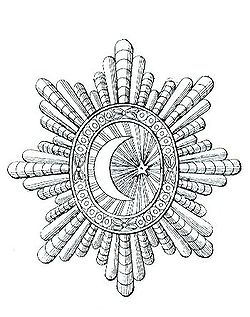Knight of the Crescent
| Order of the Crescent Hilal Nişanı |
|
|---|---|

The star of the Order of the Crescent of the Ottoman Empire
|
|
| Awarded by Ottoman Sultan |
|
| Country |
|
| Type | Order of Merit |
| Eligibility | Non-muslims |
| Awarded for | Military service |
| Status | No longer awarded |
| Statistics | |
| Established | 1799 |
The Imperial Order of the Crescent (in Ottoman Turkish Hilal Nişanı) was a chivalric order of the Ottoman Empire.
The order was instituted in 1799 by Sultan Selim III when he wished to reward Horatio Nelson, an Anglican Christian, for his victory at the Battle of the Nile. None of the existing Ottoman orders could be awarded to non-Muslims, so Selim specially created the Order of the Crescent for Nelson, making him its first Knight and sending him the insignia in August 1799. (He also rewarded Nelson with the separate award of the chelengk.) The Order was then extended to reward further British military successes on land and sea against Napoleon's forces in Egypt and the Eastern Mediterranean in 1801.
Nelson was so proud of his award that he appended it to his name in the Articles of Capitulation with Denmark after the Battle of Copenhagen on 9 April 1801 (news of which appending so pleased the Sultan that he added a ribbon and gold medal to Nelson's star). However, the British Royal Warrant at the College of Arms allowing him to wear it is only dated 20 March 1802.
Recipients (usually naval or army officers or representatives of Britain or France, highly present in the region during the Napoleonic Wars) were awarded a lozenge-shaped silver radiant star, embroidered in silver thread on an azure background with a star and crescent in the centre, and a red ribbon, to be worn with the crescent to the star's left. The order had two degrees, Knight First Class and Knight Second Class: the First Class members wore the insignia like a scarf, with the badge appendant (hung from the collar), whilst Second Class knights wore a slightly smaller version with no star, jewelling or ornamentation and a narrower ribbon saltier-wise (on a diagonal ribbon from one shoulder to the opposite waist).
...
Wikipedia
